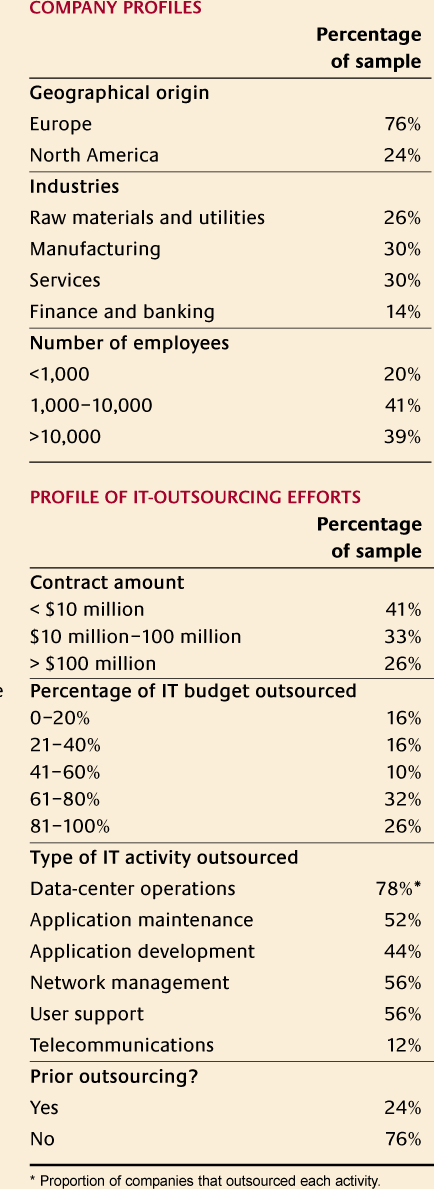The Hidden Costs of IT Outsourcing
The popularity of outsourcing is somewhat enigmatic. Why would companies entrust activities that are its lifeblood — information technology, human resources, and marketing and sales — to a third party? Yet according to “The 1999 Outsourcing Trends Report,” they do, outsourcing roughly one-third of those activities and roughly one-fifth of their financial affairs.1 The outsourcing business is booming. The report says nearly all companies spent more on outsourcing in 1999 than in 1998 and anticipate continued increases.
The report shows IT outsourcing leading the increase, with companies giving 38% of their IT functions to vendors. One reason is reduced cost. IT is one of the most expensive parts of the organization to establish and maintain. But a vendor with many clients can operate at a scale a single enterprise cannot. Large vendors can use more powerful equipment, for example, than can individual clients. Moreover, their size helps them negotiate with hardware and software providers.
Another reason companies outsource IT is improved performance. The expertise of an in-house IT department often lags behind today’s technology. A vendor’s sole job is to follow the trends and provide leading-edge software and systems. Vendors have more expertise than their individual clients because they face more-varied issues. They also can have employees specialize in areas clients typically encounter only once, such as converting to a client-server architecture. (See “An IT-Outsourcing Survey.”)
Although the benefits of IT outsourcing are clear, they often get eaten away by costs that managers can’t pinpoint. In a survey of 50 companies, about 14% of out-sourcing operations were deemed failures. Companies say they entered an out-sourcing agreement believing that they understood all major costs.
References
1. “The 1999 Outsourcing Trends Report” (New York: Michael F. Corbett & Associates Ltd., 1999) reflects the opinions of a wide variety of U.S. private- and public-sector executives and industry experts.
2. P. Ring and A. Van de Ven, “Structuring Cooperative Relationships Between Organizations,” Strategic Management Journal 13 (1992): 483–498.
3. B. Caldwell, “CIO Group With Clout — Exclusive Group Holds $60 Billion in Outsourcing Deals,” InformationWeek, June 23, 1996, www.techweb.com.
4. J. Cross, “IT Outsourcing: British Petroleum’s Competitive Approach,” Harvard Business Review 74, no. 3 (May–June 1995): 94–102.
5. B. Aubert, S. Rivard and M. Patry, “A Transaction Cost Approach to Outsourcing Behavior: Some Empirical Evidence,” Information and Management 30 (1996): 51–64.
6. R. Bettis, S. Bradley and G. Hamel, “Outsourcing and Industrial Decline,” Academy of Management Executive 6, no. 1 (February 1992): 7–22.
7.M. Useem and J. Harder, “Leading Laterally in Company Outsourcing,” Sloan Management Review 41, no. 2 (winter 2000): 25–36.
8. M. Earl, “The Risks of Outsourcing IT,” Sloan Management Review 37, no. 3 (spring 1996): 26–32.
ADDITIONAL RESOURCES
The importance of good contracts is addressed in C. Saunders, M. Gebelt and Q. Hu’s 1997 California Management Review article “Achieving Success in Information Systems Outsourcing.” The article shows that — if companies write tight contracts — IT outsourcing can be successful even when information systems are considered core functions. “The Information Systems Outsourcing Bandwagon,” by M. Lacity and R. Hirshheim in the fall 1993 Sloan Management Review, provides practical advice for negotiating contracts and suggests that IT outsourcing does not always lead to cost reductions.
Several additional MIT Sloan Management Review articles offer helpful guidance on strategic outsourcing — deciding what to outsource and what to keep in-house. M. Lacity, L. Willcocks and D. Feeny’s spring 1996 “The Value of Selective IT Outsourcing” explains that outsourcing only some IT activities generally yields better results than outsourcing an entire IT department. A. DiRomualdo and V. Gurbaxani’s “Strategic Intent for IT Outsourcing,” in the summer 1998 issue, distinguishes among three kinds of strategic intent: improve IT, improve IT’s contribution to company performance and commercially exploit IT to generate new revenues. J. Quinn and F. Hilmer’s summer 1994 “Strategic Outsourcing” defines strategic outsourcing as outsourcing noncore activities and focusing on core activities. The authors present tools that help managers determine which activities fall into which categories.
Two sources offer foundational reading on transaction-cost economics (TCE), which holds that economic activity depends on balancing production economics against transaction costs. In TCE terminology, IT-outsourcing fees are production costs; the hidden costs of IT outsourcing are transaction costs. R. Coase’s seminal article “The Nature of the Firm,” published in Economica in 1937, introduces TCE, and O.E. Williamson’s 1985 Free Press book, “The Economic Institutions of Capitalism,” develops Coase’s ideas.


Comments (2)
rusell william
P. Weiss